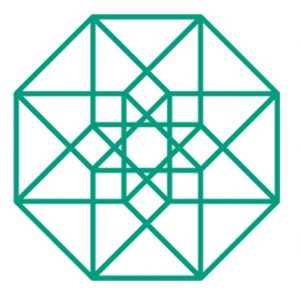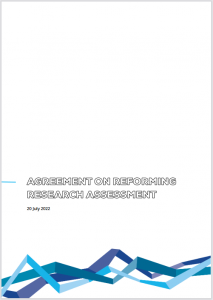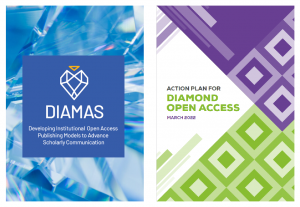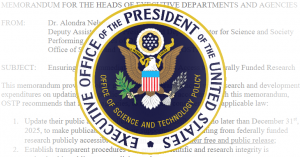The open science 2022 review summarises the key open science themes of the past year. The article brings together the policies of the national open science coordination and the main open science themes and news. The main themes include promoting responsible research assessment in Europe, supporting free of charge open access publishing (diamond OA) and the US OSTP policy.
(Tämä on yhteen veto avoimen tieteen vuosikatsauksista, jotka ovat saatavilla myös suomeksi: kansalliset linjaukset, pääteemat ja uutiset.)
Contents of the annual review of open science 2022:
- National guidelines and news from open science coordination
- Main open science themes in 2022
- 5 x Open science news from 2022
- 5 x Reading tips on open science from 2022
National guidelines and news from open science coordination
 Regarding the policy work of the national coordination of Open science and research (OScAR), sub-policies 1 and 2 of the openness of learning and open educational resources (OER) (in Finnish) were completed during the fall of 2022. The sub-policies contain guidelines on open access to educational resources and open learning and teaching practices. The action plan contains measures related to the funding of open access materials and the improvement of teachers’ skills related to OER.
Regarding the policy work of the national coordination of Open science and research (OScAR), sub-policies 1 and 2 of the openness of learning and open educational resources (OER) (in Finnish) were completed during the fall of 2022. The sub-policies contain guidelines on open access to educational resources and open learning and teaching practices. The action plan contains measures related to the funding of open access materials and the improvement of teachers’ skills related to OER.
During 2022, the policy for culture of open scholarship and the supporting recommendations (link, in Finnish), the recommendations regarding the technology of open access publishing (link, in Finnish) and the 1-2-3 guidelines regarding the interoperability of the FAIR principles (link, in Finnish) were also published.
The Committee for Public Information (TJNK) and the Federation of Finnish Learned Societies (TSV) published a recommendation for citizen science (in Finnish). Both the recommendation paper and citizen science more broadly have been discussed in the Think Open article (in Finnish). In December 2022, the citizen science guide for researchers (in Finnish) was published.
The working group that investigated the funding models of Finnish scholarly journals published its final report (pdf, in Finnish). The report presents three co-financed models, which can be used independently either simultaneously or consecutively supporting each other.
Main open science themes in 2022
The key themes of open science in 2022 were the European discussion on research evaluation, supporting measures for diamond open access publishing (free of charge open access supported by institutions), and the US OSTP policy on open science.
 In terms of research evaluation, the winds of change are currently blowing in Europe. In the summer 2022, an agreement with more than 350 European scientific organisations, the Agreement on Reforming Research Assessment, was published, and in the fall, the CoARA coalition (Coalition for Advancing Research Assessment) supporting the implementation of the agreement – by 2027 – was established. The University of Helsinki has also signed the agreement and joined the coalition. The agreement sets common goals for the responsible assessment of research, researchers and organisations, and it takes into account the different outputs of academic work more equally than at present. In responsible assessment, qualitative evaluation is emphasized instead of quantitative measures (e.g. JIF indicators or h-index). The development of researcher assessment has also been considered one of the key issues in the development of open science.
In terms of research evaluation, the winds of change are currently blowing in Europe. In the summer 2022, an agreement with more than 350 European scientific organisations, the Agreement on Reforming Research Assessment, was published, and in the fall, the CoARA coalition (Coalition for Advancing Research Assessment) supporting the implementation of the agreement – by 2027 – was established. The University of Helsinki has also signed the agreement and joined the coalition. The agreement sets common goals for the responsible assessment of research, researchers and organisations, and it takes into account the different outputs of academic work more equally than at present. In responsible assessment, qualitative evaluation is emphasized instead of quantitative measures (e.g. JIF indicators or h-index). The development of researcher assessment has also been considered one of the key issues in the development of open science.
Our vision is that the assessment of research, researchers and research organisations recognises the diverse outputs, practices and activities that maximise the quality and impact of research. This requires basing assessment primarily on qualitative judgement, for which peer review is central, supported by responsible use of quantitative indicators. Among other purposes, this is fundamental for: deciding which researchers to recruit, promote or reward, selecting which research proposals to fund, and identifying which research units and organisations to support.
– Agreement on Reforming Research Assessment, 2022
- Read more: Initiative for Science in Europen (ISE) raportissa, Centrality of researchers in reforming research assessment, presents 18 ways to reform research assessment to promote open science.
 In 2022, the global Action Plan for Diamond Open Access was launched, the aim of which is to support and develop free of charge open publishing, i.e. the so-called diamond open access model. Another major initiative, the European project DIAMAS (Developing Institutional Open Access Publishing Models to Advance Scholarly Communication) 2022–2025, also aims to strengthen the infrastructure of non-profit diamond OA publishing. The goal of the EU-funded project is to improve the conditions of institutional publishers and create common standards for publishing, and through this to build a high-level and sustainable publishing ecosystem in Europe. From Finland, the DIAMAS consortium includes TSV (Federation of Finnish Learned Societies), which runs the Journal.fi and Edition.fi diamond open access publishing services.
In 2022, the global Action Plan for Diamond Open Access was launched, the aim of which is to support and develop free of charge open publishing, i.e. the so-called diamond open access model. Another major initiative, the European project DIAMAS (Developing Institutional Open Access Publishing Models to Advance Scholarly Communication) 2022–2025, also aims to strengthen the infrastructure of non-profit diamond OA publishing. The goal of the EU-funded project is to improve the conditions of institutional publishers and create common standards for publishing, and through this to build a high-level and sustainable publishing ecosystem in Europe. From Finland, the DIAMAS consortium includes TSV (Federation of Finnish Learned Societies), which runs the Journal.fi and Edition.fi diamond open access publishing services.
The institutional OA diamond publishing sector can be challenged by fragmentation; its visibility can be limited, its service of varying quality, and its sustainability is not always secure. A new European Commission-funded project, DIAMAS, aims to build capacity amongst institutional publishers in Europe to address some of these challenges.
– SPARC Europe
 In August 2022, the Office of Science and Technology Policy (OSTP) of the White House updated its open science policy regarding research funded by US federal agencies. By 2025, peer-reviewed research publications must be immediately openly available – the previous embargo was 12 months. Research data must also be openly available at the time of publication, if there are no restrictions. The United States is the world’s largest research funder, and the OSTP policy is estimated to be comparable in terms of its content and probably also its impact to the main European research funders’s the Plan S, launched 2021.
In August 2022, the Office of Science and Technology Policy (OSTP) of the White House updated its open science policy regarding research funded by US federal agencies. By 2025, peer-reviewed research publications must be immediately openly available – the previous embargo was 12 months. Research data must also be openly available at the time of publication, if there are no restrictions. The United States is the world’s largest research funder, and the OSTP policy is estimated to be comparable in terms of its content and probably also its impact to the main European research funders’s the Plan S, launched 2021.
The taxpayers fund $5 billion a year in cancer research every year, but once it’s published, nearly all of that taxpayer-funded research sits behind walls. Tell me how this is moving the process along more rapidly.
– Vice President Joe Biden’s 2016 speech to the American Association for Cancer Research
- Read more: A report to the US Congress, Economic Landscape of Federal Public Access Policy (pdf), analyzes the economic effects of the OSTP policy.
5 x Open science news from 2022
1. Open science monitoring in Finland. The results of the monitoring of open science and research in Finland were published in October 2022 on the Research.fi portal, where the user can view the data from the perspectives of her/his choice. The results were gratifyingly good, as the majority of higher education institutions achieved a very good or excellent level of openness. In connection with the monitoring, information was also collected – for the first time – on the total costs of scientific publishing. The information on costs for the year 2021 has been gathered on the Research.fi portal.
- Read more: Open access publishing 2021 price information published in Walt Crawford’s compilation, Gold Open Access 2016–2021: Articles in Journals (GOA7).
2. TSV reports on membership of learned societies. The report published by the Federation of Finnish Learned Societies (TSV) in the fall 2022, Kuka kuuluu tieteelliseen seuraan? (Who are the members of learned societies?), gives strong support to the work done for the openness of science. 1655 people from more than 350 learned societies responded to the survey, more than 90 percent of the respondents at least somewhat agreed with the fact that it is important for scientific societies to promote the openness of research information. More than half of the Finnish scholarly journals publish their content openly. TSV also published another open science report last year, Tieteelliset seurat ja vastuullinen tiede (Learned societies and responsible science), which details the role of learned societies in responsible science in the areas of open science, research ethics and research evaluation. 116 scientific societies responded to this survey.
Membership in learned societies is motivated by a sense of community, fostering science and learning new things – – – Membership in learned societies is given up when life or work situations change. The fact that reading a learned society’s publication no longer require membership was a rare reason for giving up membership.
– Kuka kuuluu tieteelliseen seuraan? Raportti tieteellisten seurojen jäsenistökyselyn tuloksista, 2022
3. Open citations data. A significant step forward was taken in 2022 in the availability of open citations data, when reference lists of more than 60 million research publications – all publications indexed by Crossref – are now available as open data. This is the result of an effort by the Initiative for Open Citations (I4OC), launched in 2017. Opening the citation data with the most permissive CC0 license enables analyzes of research trends without publisher restrictions.
4. New data storage service at the UH. The University of Helsinki will strengthen research data storage services and data curation over the next five years with a total of 1.5 million euros (see news on the Flamma intranet). In the long-term storage of research data (Tutkimusdatan pitkäaikaistallentaminen, TPAT) project, the focus is on storing data for 5–15 years after the research – this kind of storage place has not been offered by the university before.
5. Open science group started at the UH. In autumn 2022, the University of Helsinki set up an open science coordination group, with representatives from every campus as well as research management and services. The group is tasked with coordinating the development of open science and teaching at the University. The group’s establishment was based on the UH’s strategic plan for 2021–2030, which highlights open science as one of the leading principles.
5 x Reading tips on open science from 2022
1. EOSC plans for the 2020s. ”The vision is that EOSC (European Open Science Cloud) in ten years will be similar to the internet. It will be a virtual environment, where researchers can find and access data, and also services that can ease their work in research”, summarizes Sara Garavelli (CSC) EOSC’s goals in the near future. However, among researchers, EOSC is still not well known, as researcher Anca Hienola points out. In this Think Open blog interview, EOSC aims to be the internet of research within ten years, Garavelli and Hienola discuss EOSC from the perspective of researchers and research services. We also get an answer to the question, what is EOSC’s most tangible achievement at the moment.
2. Metadata, metadata, metadata. The goal of the OSTP policy in the United States is to open – in addition to research publications – research data by 2025. However, it is a long way from the policy paper to the data being opened and usable for other researchers. In his Nature opinion, Stanford biomedical informatics professor Mark A. Musen raises the key issue of data, the production of metadata, and highlights many interesting aspects, especially from the point of view of data discoverability. The Science article Taking the pain out of data sharing discusses data sharing and data opening – yes, these are seen as different things – practices where words andestion of meta actions do not always meet. In this article too, we have to finally face the question about metadata.
If we’re serious about sharing data, we need to develop standards that can make data FAIR. – – -Scientists and their funders need to recognize that FAIR data will require more than just a mandate – such data will require an enormous investment. The research community must commit to creating discipline-specific standards for metadata and to applying them throughout the scientific enterprise.
– Mark A. Musen: Without appropriate metadata, data-sharing mandates are pointless
3. Problems with data sharing. The study published in the Journal of Clinical Epidemiology, Many researchers were not compliant with their published data sharing statement: a mixed-methods study, examined open access articles in which the authors stated that the research data was available (data availability statement, DAS). In 93 % of articles where data should have been available, it was not available. Only 14 percent of the researchers answered the data request inquiry of the authors of the study. The Nature article, Many researchers say they’ll share data — but don’t, draws attention to the same issue, and highlights related research. The article also tells about the obstacles to opening data – data is often not opened because it was not planned to be opened or it was not known what the requirements for opening are.
4. A book on Plan S. The Plan S to foster open access publishing launched by major European research funders in 2018 is one of the key open access initiatives of recent years. The history of the creation of Plan S has now been published: in the openly available book, Plan S for Shock (2000), the narrator is Robert-Jan Smits, one of the main architects of Plan S, and the co-author is journalist Rachael Pells. In the book, Smits points out that Plan S is only an intermediate step on the way to the openness of scientific publications. A real cultural change will only happen when the evaluation and merit system regarding research and researchers, as well as research organisations, changes.
4. New podcast. In the fall of 2022, the Helsinki University Library’s Avoimella otteella podcast (in Finnish) started. The podcast is hosted by Aleksi Peura, known from the Humanisti datamaailmassa blog series. In the podcast, Peura discusses various research topics with his academic guests, and also raises issues of open science, e.g. related to methods, research data, teaching materials or self-archiving.
Previous annual reviews of open science:
- Annual review 2021: The open science annual review 2021: key topics and news
- Annual review 2020: The open science annual review picks up the main topics in 2020: from Plan S to coronavirus pandemic
- Annual review 2019: The open science annual review summarizes the main topics for 2019
